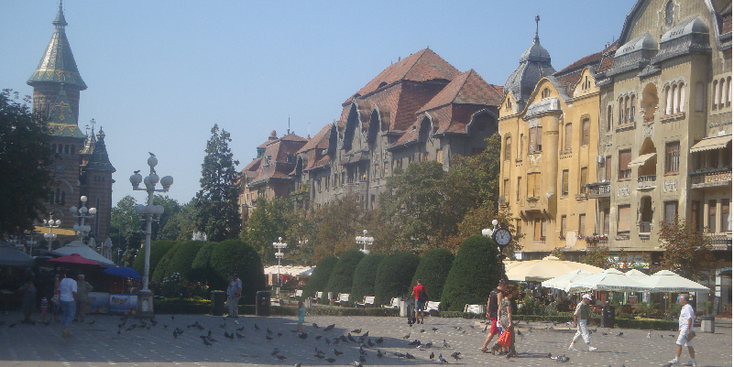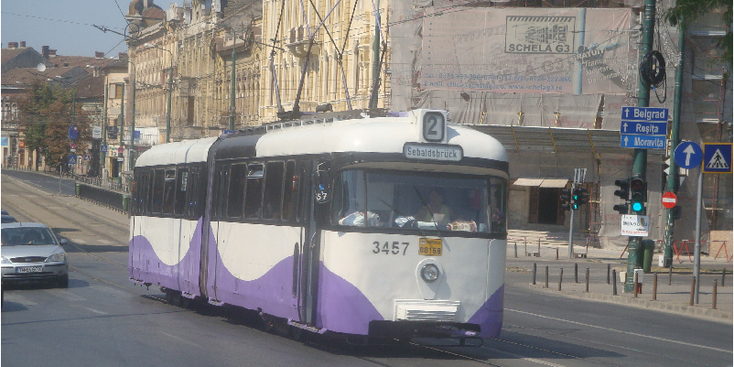Timisoara
Places of Interest - Romania


introduction
Timisoara is Romania's fourth city and is known as the city of flowers given the large number of parks within her city-limits. It is cut in the middle by the river Bega and is one of the most multicultural and developed of the country. Also the term "little Vienna" is sometimes used due to the large number of buildings that date from the baroque and the second half of the 19th century when Timisoara was still part of Hungary.
The city hosts a large number of minorities such as Hungarians (until 1920 the region belonged to the Austro-Hungarian Empire), Serbs and Germans. This last group was even the dominant population group until WWII. Because Timi is at a strategic location, it is not surprising that it is a very important train, bus and airplane hub.
In 1989, Timisoara became world news when the communist authorities (lead by dictator Ceausescu) tried to arrest pastor Laszlo Tokes and unleash his own demise. The capital of the "Banat" region, which was not liked by the old dictator anyway, is therefore sometimes called Primul Oras Liber - the first free city in the country.
highlights

The old town:
In fact, the city Timisoara has two centers; the square Piata Unirrii (the unit square) where the large yellow Baroque Roman Catholic church stands as well as the Serbian Orthodox Cathedral.
The other is the elongated victory square Piata Victoriei which is closed on the south side flanked by the largest Romanian Orthodox cathedral in the country. On the other side of the square (with a large rectangular park between the buildings with beautiful flowers) is the Opera.
Near the cathedral is a modern statue which serves as a memorial for the fallen during the Revolution. In between is the cozy, almost romantic enchanting square (Piata Libertatii) along which the old town hall is located. You can also find the public library here.
Tokes Reformed Church:
Express your respect by taking a look at the church where Laszlo Tokes (Hungarian pastor) dared to openly criticize Communist dictator Ceausescu and his regime. The church is just south of the center.
Other attractions:
- The ZHH Termal complex where you can swim, among other things.

history
The area in which Timisoara is situated was already in the 6th century BC inhabited and would begin to belong to the Roman region "Dacia". From the 9th to the middle of the 16th century it was under the rule of the Hungarians. Timisoara owes its name to a Hungarian castle that was built on the river Timis.
The Ottomans conquered the provinces Banat and Crisana in 1552 on the Hungarians and bombed it as the capital of the region. In the year 1699 Hungary belonged to Austria but the provinces Banat and Crisana remained under Turkish control until the year 1716 when the Habsburg prince Eugene of Savoy defeated the Ottomans for good.
In 1718 the city came under the rule of the double monarchy Austria-Hungary and more and more Habsburgs (Czechs, Germans and Slovaks) were sent to this area to "settle" here. The second half of the 19th century was characterized by a flourishing period. Timisoara was connected to the railnetwork and the "de Bega" river was channeled. Since the end of WWI and the abolition of the double monarchy, Timisoara belongs to Romania with the historic provinces Banat and Crisana falling apart in three countries (Romania, Hungary and the then Yugoslavia).
At the end of December 1989, protests in the city led to the Romanian Revolution, reason for the down fall of the communist dictator Ceausescu. The Hungarian vicar who criticized the flamboyant dictator with his wild ideas for years, would be arrested and the people of this very multicultural and Western city didn’t take it anymore and went en masse on the streets. Approximately 70 people lost their lives during this fuss.

tips & advice (2013)

The "Eurolines" office (read: stand) is located within walking distance of the center - it is located in a residential area in
the northeast of the city. In addition, to my knowledge there are four bus stations - one is in the northeast of the city (I have never seen that).
Then in the southwest there are three - a very small one where I have only seen a minibus, the other is the (I assume) international bus station where large busses leave elsewhere and one next to the train station.
Timisoara - Deva: at 10:00 a big bus (air-conditioned) goes to Deva. It takes about 3 hours and it costs 30 Lei. Buy a ticket from the driver. From there you can transfer to a minibus in the direction of Hunedoara (half an hour, 6 Lei) which goes very often and also direction Sibiu (about 2,5 hours - costs 28 Lei).

There is a very nice terrace near the Tokes church in the southeast of the city - a beer (half liter) costs 4 to 5 Lei and you have a beautiful view of the street. Nice and good service but make sure they pay everything back (change).

-
Name: Directia Juedteana Pentru Sport Si Tineret Tims
Address: P-ta Tahcu Huniade 3
Price: 50 Lei (single)
Phone nr. : 0256-490469
Email: djt.timis@yahoo.com
Content:
My travel guide stated that this is a youth hostel but I doubt it. It looks more like a school or something - it is a large building near the center in a quiet street. Behind it is a large school area and the corridors also have something like a school. At the reception a number of old men in turns to give you a receipt of payment and to keep the administration up to date. This may take a while.
The rooms are fine - there is a very clean toilet and shower area (there is sometimes hot water) and they are spacious with three beds, a closet, desk and chair. The bed itself has a pretty bad suspension but is clean and comes with sheets and blanket. There is also a stove available.
It is all in all very quiet here and price / quality ratio is fine. WIFI is sometimes there, but no idea if this belongs to the hostel yes / no.

see also:
LANDEN:
EUROPA:
Albanië * België * Bosnië-Herzegovina * Bulgarije * Denemarken * Duitsland * Engeland * Estland * Finland * Frankrijk * Griekenland * Hongarije * (Noord) Ierland * Italië * Kosovo * Kroatië * Letland * Litouwen * Luxemburg * Macedonië * Malta * Montenegro * NEDERLAND * Oekraïne * Oostenrijk * Polen * Portugal * Roemenië * Rusland * Schotland * Servië * Slovenië * Slowakije * Spanje * Tsjechië * Turkije * Zweden
NOORD EN CENTRAAL-AMERIKA:
Chili * Costa Rica * Cuba * Guatemala * Mexico * Nicaragua * Panama * Verenigde Staten
ZUID-AMERIKA:
Argentinië * Bolivia * Brazilië * Colombia * Ecuador * Peru
AFRIKA:
Botswana * Burkina Faso * Egypte * Ethiopië * Ghana * Kenia * Mali * Marokko * Namibië * Oeganda * Senegal * Tanzania * Tunesië * Zuid-Afrika
MIDDEN-OOSTEN:
Iran * Israël * Jordanië * V.A.E.
AZIE:
Armenië * Cambodja * China * Filipijnen * Georgië * India * Indonesië * Japan * Kirgizië * Laos * Maleisië * Mongolië * Myanmar * Nepal * Oezbekistan * Singapore * Sri Lanka * Thailand * Vietnam
OCEANIE:
Voor meer reisfoto's kijk op www.instagram.com/cheapskatetravel.nl:
© Cheapskatetravel.nl; 2018 (all rights reserved)

